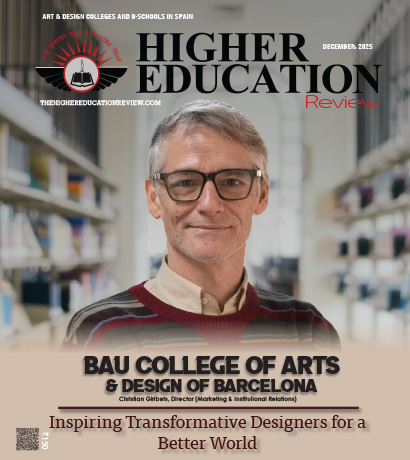Design -Centric Education Imperative For The Post Covid World And Atmanirbhar Bharat

Sudhir Varadarajan, Dean (Design, Innovation & Incubation) IIITDM Kancheepuram
Education disrupted
The disruption unleashed by COVID-19 has shaken the education system at all levels - primary, secondary, and higher education. However, institutions seem to hold on to their discipline/faculty-centric and teaching-oriented model. Most are busy transferring this model into online platforms with controls such as attendance and proctored online exams. On the other hand, students are figuring out ways to make sense of the burgeoning academic knowledge and expectations, while grappling with issues of internet connectivity, availability of computers, ergonomics of increased screen time, and learning to beat the system. The fundamental qualities of learning the real-world continue to be accidental biproducts, if at all.
Will NEP make any difference?
The introduction of the National Education Policy (NEP 2020) in this context raises hope. The NEP calls for increasing choices for students, creating more wholesome and multi-disciplinary learning environment and experiences, and encourage innovation. This vision has been welcomed by many individuals and institutions. The implementation approach has started pushing higher education institutions (HEIs) to make interventions such as increasing the proportion of open electives, create new minors/majors, increase the student strength and add new departments/disciplines to create a multi-disciplinary environment. However, a key concern is whether these interventions, implemented within the faculty-centric and teaching-oriented mindset, will create a wholesome learning experience that dissolves the dichotomy between mind-body, local-global and produce a self-directed learner who has the passion and drive to make a difference to the local issues? And whether they will help evolve new models of education that weave India's past with the future as envisaged by Gandhi and Tagore?
Design-centric education for multi-disciplinary learning
While NEP (Section 11, para 11.2) argues that "assessment of educational approaches in undergraduate education that integrate the Humanities and Arts with Science, Technology, Engineering and Mathematics (STEM) have consistently showed positive learning outcomes, including increased creativity and innovation, critical thinking and higher-order thinking capacities.....", it does not throw much light on these approaches or different models of education. The one approach that is highly relevant to realize the vision of NEP design education is surprisingly not discussed in the NEP. While there are 31 references to the word "design or designed or redesigned" in the NEP, and a reference to design thinking as one among that many competing subjects to be taught, the NEP seems to have missed the significant role that design education can play in the implementation.
“The two key processes of design education (a) creating an environment that nurtures curiosity and making aesthetics and creativity as integral to learning and not an afterthought, and (b) giving primacy to practice and value creation”
The two key processes of design education (a) creating an environment that nurtures curiosity and making aesthetics and creativity as integral to learning and not an afterthought, and (b) giving primacy to practice and value creation are critical for effective implementation of NEP and evolve new models of education. The long foundation programs in design education focus on helping students unlearn the negative effects of schooling, and take ownership for self-directed learning, experimentation and risk taking. The focus on practice through a studio environment (unlike a lab or a research center) helps students and faculty to collaboratively learn and create industry and socially relevant innovation. It is through immersion in these two processes that design enables interdisciplinarity and tight integration between STEM and Humanities, Arts and Social Sciences.
Integrative structures for design-centric education
However, embracing design and developing design-centric education programs at undergraduate, postgraduate and PhD levels will not be easy. The key element in this transformation faculty is paradoxically both the enabler and the Achilles heel. Faculty will need lot of support to transition from a department focused and teaching-oriented model to a student-centric and interdisciplinary learning-oriented model. Institutions must develop integrative structures at institutional and program levels to encourage faculty to make this shift. Given the complexity of this task, it appears that single stream institutions with strong leadership may be better placed to evolve new models of design-centric education when compared to some of the well-established large institutions where design is treated as another department. Large institutions can look at similar experiments in other part of the world, notably the New Engineering Education Transformation (also called as NEET) initiative being undertaken at MIT. NEP must be the trigger to develop design-centric and blended models that integrate learning, innovating, and working at scale. National assessment frameworks like the Atal Ranking of Institutions on Innovation Achievement may have to be tweaked to identify and nurture promising models that promote Atmanirbhar Bharat.
Sudhir Varadarajan, Dean
With his 20+ years' experience in the Indian IT industry in R&D, Practice Development and Consulting, and specialization in Systems Engineering & Management, he leads the institute's design, innovation and incubation.
The disruption unleashed by COVID-19 has shaken the education system at all levels - primary, secondary, and higher education. However, institutions seem to hold on to their discipline/faculty-centric and teaching-oriented model. Most are busy transferring this model into online platforms with controls such as attendance and proctored online exams. On the other hand, students are figuring out ways to make sense of the burgeoning academic knowledge and expectations, while grappling with issues of internet connectivity, availability of computers, ergonomics of increased screen time, and learning to beat the system. The fundamental qualities of learning the real-world continue to be accidental biproducts, if at all.
Will NEP make any difference?
The introduction of the National Education Policy (NEP 2020) in this context raises hope. The NEP calls for increasing choices for students, creating more wholesome and multi-disciplinary learning environment and experiences, and encourage innovation. This vision has been welcomed by many individuals and institutions. The implementation approach has started pushing higher education institutions (HEIs) to make interventions such as increasing the proportion of open electives, create new minors/majors, increase the student strength and add new departments/disciplines to create a multi-disciplinary environment. However, a key concern is whether these interventions, implemented within the faculty-centric and teaching-oriented mindset, will create a wholesome learning experience that dissolves the dichotomy between mind-body, local-global and produce a self-directed learner who has the passion and drive to make a difference to the local issues? And whether they will help evolve new models of education that weave India's past with the future as envisaged by Gandhi and Tagore?
Design-centric education for multi-disciplinary learning
While NEP (Section 11, para 11.2) argues that "assessment of educational approaches in undergraduate education that integrate the Humanities and Arts with Science, Technology, Engineering and Mathematics (STEM) have consistently showed positive learning outcomes, including increased creativity and innovation, critical thinking and higher-order thinking capacities.....", it does not throw much light on these approaches or different models of education. The one approach that is highly relevant to realize the vision of NEP design education is surprisingly not discussed in the NEP. While there are 31 references to the word "design or designed or redesigned" in the NEP, and a reference to design thinking as one among that many competing subjects to be taught, the NEP seems to have missed the significant role that design education can play in the implementation.
“The two key processes of design education (a) creating an environment that nurtures curiosity and making aesthetics and creativity as integral to learning and not an afterthought, and (b) giving primacy to practice and value creation”
The two key processes of design education (a) creating an environment that nurtures curiosity and making aesthetics and creativity as integral to learning and not an afterthought, and (b) giving primacy to practice and value creation are critical for effective implementation of NEP and evolve new models of education. The long foundation programs in design education focus on helping students unlearn the negative effects of schooling, and take ownership for self-directed learning, experimentation and risk taking. The focus on practice through a studio environment (unlike a lab or a research center) helps students and faculty to collaboratively learn and create industry and socially relevant innovation. It is through immersion in these two processes that design enables interdisciplinarity and tight integration between STEM and Humanities, Arts and Social Sciences.
Integrative structures for design-centric education
However, embracing design and developing design-centric education programs at undergraduate, postgraduate and PhD levels will not be easy. The key element in this transformation faculty is paradoxically both the enabler and the Achilles heel. Faculty will need lot of support to transition from a department focused and teaching-oriented model to a student-centric and interdisciplinary learning-oriented model. Institutions must develop integrative structures at institutional and program levels to encourage faculty to make this shift. Given the complexity of this task, it appears that single stream institutions with strong leadership may be better placed to evolve new models of design-centric education when compared to some of the well-established large institutions where design is treated as another department. Large institutions can look at similar experiments in other part of the world, notably the New Engineering Education Transformation (also called as NEET) initiative being undertaken at MIT. NEP must be the trigger to develop design-centric and blended models that integrate learning, innovating, and working at scale. National assessment frameworks like the Atal Ranking of Institutions on Innovation Achievement may have to be tweaked to identify and nurture promising models that promote Atmanirbhar Bharat.
Sudhir Varadarajan, Dean
With his 20+ years' experience in the Indian IT industry in R&D, Practice Development and Consulting, and specialization in Systems Engineering & Management, he leads the institute's design, innovation and incubation.

